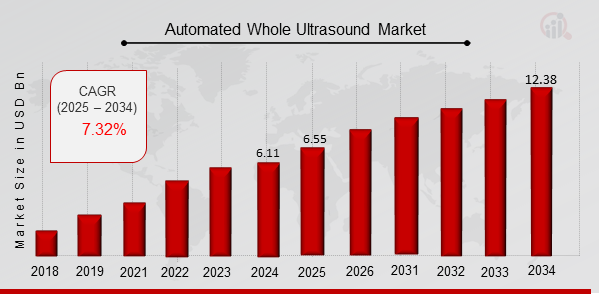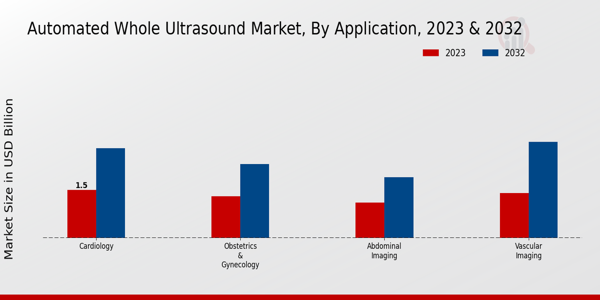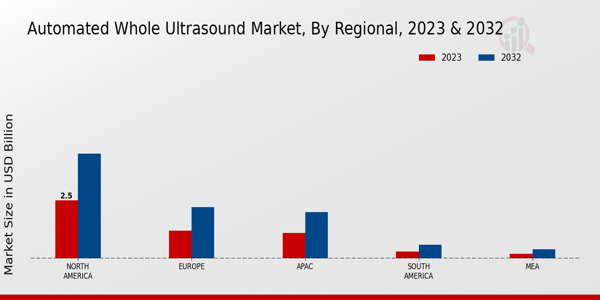Automated Whole Ultrasound Market Overview
As per MRFR analysis, the Automated Whole Ultrasound Market Size was estimated at 6.11 (USD Billion) in 2024. The Automated Whole Ultrasound Market Industry is expected to grow from 6.55 (USD Billion) in 2025 to 12.38 (USD Billion) till 2034.
The CAGR (growth rate) is expected to be around 7.32% during the forecast period (2025 - 2034).
Key Automated Whole Ultrasound Market Trends Highlighted
The Automated Whole Ultrasound Market is primarily driven by the rising demand for non-invasive diagnostic tools in healthcare facilities. The growing prevalence of chronic diseases and an aging population are increasing the need for early diagnosis and monitoring.
Moreover, technological advancements in ultrasound systems are making them more efficient and accurate, thereby attracting more healthcare providers to adopt these solutions. Automation in ultrasound offers improved workflow and reduced operational costs, which are crucial factors influencing market growth.
Additionally, the expansion of telemedicine and the integration of AI in ultrasound technologies provide further impetus to market development. Opportunities in this market are abundant as healthcare facilities look to enhance their diagnostic capabilities.
The increasing adoption of portable and handheld ultrasound devices opens new avenues for remote diagnostics, particularly in underserved and rural areas. There is significant potential for innovation in imaging techniques and data analysis, facilitating more comprehensive assessments of patient health.
Collaborations between technology companies and healthcare providers can lead to the development of customized solutions catering to specific medical needs. As a result, startups and established companies in the field have the chance to capture a larger market share by addressing specific user requirements.
Recently, trends have shifted towards integrating artificial intelligence and machine learning with ultrasound technology. These advancements are streamlining diagnostic processes, allowing for faster and more accurate interpretations of ultrasound images.
The focus is also on developing user-friendly interfaces that can be operated by non-specialist healthcare providers. This trend not only improves accessibility but also increases the number of professionals who can use ultrasound tools.
Overall, the automated whole ultrasound market is evolving rapidly, driven by technological developments and the increasing need for efficient healthcare solutions. As these trends continue to shape the market, a collaborative and innovative approach will be essential for capturing future growth opportunities.

Source: Primary Research, Secondary Research, Market Research Future Database and Analyst Review
Automated Whole Ultrasound Market Drivers
Technological Advancements in Ultrasound Technology
The Automated Whole Ultrasound Market Industry has witnessed significant technological advancements that have transformed the way ultrasound imaging is performed. Innovations in hardware, software, and imaging technologies have led to the development of automated ultrasound systems that offer higher precision and improved diagnostic capabilities.
These state-of-the-art systems are equipped with advanced algorithms that automate image acquisition and analysis, minimizing the need for manual intervention and reducing the likelihood of human errors. Moreover, the integration of artificial intelligence (AI) and machine learning into ultrasound systems enhances image interpretation, making it quicker and more accurate.
This is crucial for early disease detection, especially in applications like prenatal imaging, cardiology, and oncology, where timely diagnosis can significantly influence treatment outcomes. The growing popularity of point-of-care ultrasound (POCUS) across various healthcare settings, including hospitals, clinics, and home healthcare, has further driven demand in the Automated Whole Ultrasound Market Industry.
These advancements not only improve patient care but also streamline workflows and enhance operational efficiency in healthcare facilities, making automated ultrasound systems an essential tool for modern diagnostics.
Increasing Demand for Non-Invasive Diagnostic Procedures
In recent years, there has been a marked increase in the demand for non-invasive diagnostic procedures within the Automated Whole Ultrasound Market Industry. Patients and healthcare providers alike favor non-invasive methods due to their safety, comfort, and minimal recovery time compared to traditional invasive techniques.
Ultrasound imaging stands out as a leading non-invasive tool that provides valuable real-time visual information about various internal organs and tissues. This rising preference for non-invasive diagnostics is driven by the growing awareness among patients regarding the risks associated with invasive procedures and a collective emphasis on patient-centered care.
As healthcare systems adapt to this demand, automated ultrasound systems are positioned to cater to the rising patient needs, thereby bolstering market growth and paving the way for enhanced healthcare delivery.
Growing Aging Population and Chronic Disease Prevalence
The Automated Whole Ultrasound Market Industry is significantly influenced by the growing aging population and the rising prevalence of chronic diseases. As societies around the world continue to age, the demand for diagnostic imaging services, particularly for conditions like cardiovascular diseases, cancer, and musculoskeletal disorders, is on the rise.
Automated ultrasound systems provide critical support in diagnosing these chronic conditions, allowing for regular monitoring and management of patient health. The elderly population often requires more frequent medical attention and will benefit from the precision and efficiency of automated systems.
Therefore, as the patient population increases, fueled by both aging demographics and escalating chronic disease rates, the Automated Whole Ultrasound Market Industry is anticipated to see substantial growth driven by the burgeoning demand for effective and efficient diagnostic solutions.
Automated Whole Ultrasound Market Segment Insights
Automated Whole Ultrasound Market Application Insights
The Automated Whole Ultrasound Market exhibits significant growth across various applications, which are critical to the healthcare industry. In 2023, the total market value reached 5.3 USD Billion, reflecting a robust demand for automated ultrasound solutions.
Notably, the cardiology application is valued at 1.5 USD Billion in 2023, and it is projected to increase to 2.8 USD Billion by 2032, showcasing its dominance and importance due to the rising prevalence of cardiovascular diseases and the need for efficient diagnostic methods.
Similarly, the obstetrics and gynecology application, valued at 1.3 USD Billion in 2023, is expected to grow to 2.3 USD Billion by 2032, driven by advancements in prenatal care and an increasing focus on women’s health.
In-depth imaging capabilities in this segment ensure the early detection of complications, thus enhancing patient outcomes. The abdominal imaging application holds a market value of 1.1 USD Billion in 2023, with anticipated growth to 1.9 USD Billion by 2032.
This segment plays a vital role in diagnosing various conditions related to the liver, kidney, and pancreas, enabling healthcare providers to deliver timely interventions. Furthermore, vascular imaging is notably significant, with a current value of 1.4 USD Billion expected to rise to 3.0 USD Billion by 2032.
This rapid growth is largely driven by the increasing incidence of vascular diseases and the consequent demand for non-invasive imaging techniques that aid in timely diagnosis and treatment planning. Overall, the continuous advancements in ultrasound technology, alongside a growing emphasis on preventive healthcare, propel the Automated Whole Ultrasound Market forward, creating vast opportunities and driving market growth in these key applications.

Source: Primary Research, Secondary Research, Market Research Future Database and Analyst Review
Automated Whole Ultrasound Market End User Insights
The Automated Whole Ultrasound Market is expected to reach a valuation of 5.3 billion USD in 2023 and shows promising growth potential over the next decade. This market is characterized by various end users, including hospitals, diagnostic imaging centers, academic and research institutions, and outpatient clinics.
Hospitals significantly dominate this space due to their capacity to invest in advanced technology and the consistent demand for diagnostic imaging services. Diagnostic imaging centers also play a critical role as they specialize in imaging services, fostering quicker diagnoses and patient management, thus contributing notably to market growth.
Academic and research institutions are vital for innovation, as they often lead in developing new applications and refining ultrasound technologies, driving further enhancements in the industry. Outpatient clinics, while smaller, represent a growing segment addressing the demand for accessible and immediate diagnostic services.
The diverse application across these end users fuels the overall expansion of the Automated Whole Ultrasound Market, with growth driven by technological advancements and increasing awareness of preventive healthcare.
Automated Whole Ultrasound Market Type Insights
The Automated Whole Ultrasound Market is projected to be valued at 5.3 USD Billion in 2023 and is expected to witness steady growth driven by advancements in ultrasound technology and an increasing demand for non-invasive diagnostic solutions.
The market segmentation of this industry encompasses various types, including 2D Ultrasound, 3D Ultrasound, 4D Ultrasound, and Doppler Ultrasound, with each type catering to specific diagnostic needs. 2D Ultrasound remains a fundamental pillar in obstetric and gynecological imaging, playing a crucial role in prenatal care.
Meanwhile, 3D Ultrasound enhances anatomical visualization, greatly benefiting fields like cardiology and fertility treatments. The 4D Ultrasound, known for its real-time imaging capabilities, provides dynamic views that are particularly useful during fetal monitoring.
Doppler Ultrasound, on the other hand, is instrumental in assessing blood flow and heart conditions, thus dominating certain clinical practices due to its precise diagnostics. As healthcare professionals increasingly embrace automation, the Automated Whole Ultrasound Market is set to flourish, revealing opportunities amid the continuous evolution of medical imaging technologies.
Automated Whole Ultrasound Market Modality Insights
The Automated Whole Ultrasound Market, valued at 5.3 billion USD in 2023, exhibits a diversified range of modalities that enhance diagnostic capabilities. This market segmentation includes Portable Ultrasound, Stationary Ultrasound, and Handheld Ultrasound, each playing a vital role in healthcare delivery.
Portable Ultrasound devices are gaining traction due to their convenience and accessibility, particularly in remote healthcare settings. Meanwhile, Stationary Ultrasound remains crucial in hospitals for detailed imaging and complex diagnostics, showcasing its integral role in traditional medical practice.
Handheld Ultrasound, though relatively newer, offers significant advantages in point-of-care scenarios, making it increasingly popular among healthcare professionals. The growth of the Automated Whole Ultrasound Market is driven by technological advancements, increasing demand for minimally invasive procedures, and a rising focus on preventive healthcare.
However, challenges such as high costs of advanced equipment and regulatory hurdles may impact market expansion. Overall, the market's growth reflects a strong momentum that is supported by its diverse modalities and their unique contributions to improving patient care.
Automated Whole Ultrasound Market Regional Insights
The Automated Whole Ultrasound Market is projected to have significant growth across various regions. In 2023, North America leads the market with a valuation of 2.5 USD Billion, expected to expand to 4.5 USD Billion by 2032, highlighting its dominance in technological advancements and healthcare infrastructure.
Europe follows with a valuation of 1.2 USD Billion in 2023, anticipated to reach 2.2 USD Billion by 2032, driven by increasing healthcare expenditures and a growing awareness of early diagnosis. The APAC region, valued at 1.1 USD Billion in 2023, is set to grow to 2.0 USD Billion by 2032, fueled by rising investments in healthcare modernization and increasing patient population.
South America stands at 0.3 USD Billion in 2023, with projections of reaching 0.6 USD Billion by 2032, indicating a budding market driven by improving healthcare policies. Meanwhile, the MEA region, at 0.2 USD Billion in 2023, is expected to grow to 0.4 USD Billion by 2032, reflecting growing access to advanced ultrasound technology in emerging economies.
Overall, the Automated Whole Ultrasound Market revenue showcases a diverse landscape, with distinct growth potentials influenced by regional healthcare trends and economic factors.

Source: Primary Research, Secondary Research, Market Research Future Database and Analyst Review
Automated Whole Ultrasound Market Key Players and Competitive Insights
The Automated Whole Ultrasound Market is witnessing significant advancements driven by technological innovations and increasing healthcare demands. This sector is characterized by a dynamic competitive landscape where various companies strive to enhance their product offerings and capture market share.
Key players in the industry are focusing on developing advanced ultrasound solutions that improve diagnostic efficiency, reduce the need for human intervention, and provide high-quality imaging results. Competitive strategies, including mergers and acquisitions, partnerships, and extensive RD investments, are prevalent among companies looking to secure their footing in this rapidly evolving market.
The growing emphasis on point-of-care ultrasound and telemedicine further intensifies competition as companies aim to meet the needs of healthcare providers and improve patient outcomes.
Sonoscape has established a noteworthy presence in the Automated Whole Ultrasound Market by leveraging its strengths to deliver innovative ultrasound technology. The company is recognized for its commitment to high-quality imaging devices that cater to various clinical applications.
Sonoscape’s ability to integrate advanced features like automated measurements and real-time imaging enhances the usability of its products while providing reliable diagnostic support. The brand's strong distribution network and customer service capabilities allow it to effectively reach diverse markets and maintain customer satisfaction.
Moreover, Sonoscape continuously invests in research and development, enabling it to stay ahead of the competition by meeting evolving healthcare demands with cutting-edge automated ultrasound solutions.
Canon Medical Systems plays a significant role in the Automated Whole Ultrasound Market, known for its dedication to delivering high-performance imaging technologies. The company's products incorporate advanced artificial intelligence and automation to optimize ultrasound procedures, which enhances the efficiency and accuracy of diagnostics.
Canon Medical Systems is also recognized for its commitment to user-friendly interfaces and workflow enhancements, allowing healthcare professionals to perform examinations with ease. The company focuses on innovation driven by user feedback, ensuring that its ultrasound systems are adaptable to the changing needs of medical practitioners.
With a strong emphasis on patient safety and care quality, Canon Medical Systems continues to strengthen its position in the market, providing reliable and technologically advanced ultrasound solutions that cater to diverse healthcare environments.
Key Companies in the Automated Whole Ultrasound Market Include
- Sonoscape
- Canon Medical Systems
- Hologic
- Analogic Corporation
- Philips Healthcare
- Esaote
- Mindray
- Siemens Healthineers
- Fujifilm Holdings
- Terason
- Samsung Medison
- Medtronic
- Hitachi Medical Systems
- Clarius Mobile Health
- GE Healthcare
Automated Whole Ultrasound Market Industry Developments
The Automated Whole Ultrasound Market has recently experienced significant developments, with companies such as GE Healthcare and Siemens Healthineers leading innovations in imaging technology to improve diagnostic efficiency. Sonoscape has focused on expanding its product portfolio, while Philips Healthcare has enhanced its ultrasound systems to cater to a broader range of medical applications.
Hologic has made strides in women's health imaging, emphasizing the growing demand for specialized ultrasound solutions. In terms of mergers and acquisitions, Fujifilm Holdings is known to be eyeing strategic partnerships to strengthen its market presence, while Canon Medical Systems has also pursued collaborations to enhance its capabilities.
The growth in market valuation is largely attributed to the increasing demand for non-invasive diagnostic tools, as well as advancements in automation technologies that improve imaging accuracy and workflow efficiency. This growth is further fueled by the rising prevalence of chronic diseases and an aging population, prompting healthcare providers to invest more in advanced ultrasound solutions.
Mindray and Esaote are also responding to these trends by rolling out innovative offerings that address both patient and practitioner needs in clinical settings. The competitive landscape remains vibrant, showcasing the industry's potential for further expansion.
Automated Whole Ultrasound Market Segmentation Insights Automated Whole Ultrasound Market Application Outlook
- Cardiology
- Obstetrics Gynecology
- Abdominal Imaging
- Vascular Imaging
Automated Whole Ultrasound Market End User Outlook
- Hospitals
- Diagnostic Imaging Centers
- Academic Research Institutions
- Outpatient Clinics
Automated Whole Ultrasound Market Type Outlook
- 2D Ultrasound
- 3D Ultrasound
- 4D Ultrasound
- Doppler Ultrasound
Automated Whole Ultrasound Market Modality Outlook
- Portable Ultrasound
- Stationary Ultrasound
- Handheld Ultrasound
Automated Whole Ultrasound Market Regional Outlook
- North America
- Europe
- South America
- Asia Pacific
- Middle East and Africa
| Report Attribute/Metric |
Details |
|
Market Size 2024
|
6.11 (USD Billion)
|
|
Market Size 2025
|
6.55 (USD Billion)
|
|
Market Size 2034
|
12.38 (USD Billion)
|
|
Compound Annual Growth Rate (CAGR)
|
7.32 % (2025 - 2034)
|
|
Report Coverage
|
Revenue Forecast, Competitive Landscape, Growth Factors, and Trends
|
|
Base Year
|
2024
|
|
Market Forecast Period
|
2025 - 2034
|
|
Historical Data
|
2020 - 2024
|
| Market Forecast Units |
USD Billion |
| Key Companies Profiled |
Sonoscape, Canon Medical Systems, Hologic, Analogic Corporation, Philips Healthcare, Esaote, Mindray, Siemens Healthineers, Fujifilm Holdings, Terason, Samsung Medison, Medtronic, Hitachi Medical Systems, Clarius Mobile Health, GE Healthcare |
| Segments Covered |
Application, End User, Type, Modality, Regional |
| Key Market Opportunities |
Increased adoption in rural areas, Advancements in AI technology, Growing demand for early diagnosis, Rising awareness of preventive healthcare, Expanding applications in various specialties |
| Key Market Dynamics |
Technological advancements, Increasing prevalence of chronic diseases, Growing demand for point-of-care diagnostics, Rising adoption of telemedicine, Cost-effectiveness of automated systems |
| Countries Covered |
North America, Europe, APAC, South America, MEA |
Frequently Asked Questions (FAQ):
The Automated Whole Ultrasound Market is expected to be valued at 12.38 USD Billion in 2034.
The CAGR for the Automated Whole Ultrasound Market from2025 to 2034 is projected to be 7.32%.
North America is expected to hold the largest market share, valued at 4.5 USD Billion in 2032.
The Cardiovascular application is valued at 1.5 USD Billion in 2023 and is projected to reach 2.8 USD Billion by 2032.
Key players in the market include companies such as Canon Medical Systems, Hologic, and Philips Healthcare.
The Obstetrics Gynecology application is projected to be valued at 2.3 USD Billion in 2032.
The Vascular Imaging market is valued at 1.4 USD Billion in 2023, and it is expected to reach 3.0 USD Billion in 2032.
In Europe, the Automated Whole Ultrasound Market is expected to be valued at 2.2 USD Billion by 2032.
The market is poised for growth due to advancements in technology and an increasing demand for non-invasive diagnostic procedures.
The Abdominal Imaging application is anticipated to reach a market value of 1.9 USD Billion in 2032.

















